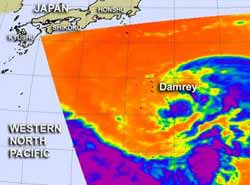NASA sees compact Tropical Storm Damrey approaching southern Japan

NASA's Aqua satellite passed over Tropical Storm Damrey on July 29 at 11:21 p.m. EDT and the AIRS instrument captured an infrared image of the storm. It showed that strong, high, cold cloud tops of thunderstorms (purple) were in a tight circle around the center of circulation.<br>Credit: Credit: NASA JPL, Ed Olsen<br>
NASA's Aqua satellite passed over Tropical Storm Damrey on July 30 at 03:21 UTC (July 29 at 11:21 p.m. EDT) and the Atmospheric Infrared Sounder (AIRS) instrument captured an infrared image of the storm. It showed that strong, high, cold cloud tops of thunderstorms were in a tight circle around the center of circulation.
There were bands of thunderstorms mostly north and east of the center of circulation. Some of the thunderstorm cloud tops were so high that they were as cold as -63 Fahrenheit/-52 Celsius. The circle of thunderstorms appears compact in the infrared imagery.
Damrey formed as a depression on July 28. By July 30, Damrey reached tropical storm status. Damrey's maximum sustained winds were near 45 knots (51.7 mph/83.3 kmh) at 11 a.m. EDT (1500 UTC) on July 30. Tropical-storm-force winds extend out 50 nautical miles (57.5 miles/92.6 km) from the center, making the storm just over 100 miles (115 miles/185 km) in diameter. Damrey was located about 175 nautical miles (201.4 miles/324 km) east-northwest of Iwo To, near 26.3 North and 143.6 East. It is moving to the west-northwest at 5 knots (5.7 mph/9.2 kmh).
Forecasters at the Joint Typhoon Warning Center expect Damrey to track to the west-northwest over the next three days. It is currently expected to strengthen and then weaken before it makes landfall north of Shanghai, China on August 3.
Media Contact
More Information:
http://www.nasa.govAll latest news from the category: Earth Sciences
Earth Sciences (also referred to as Geosciences), which deals with basic issues surrounding our planet, plays a vital role in the area of energy and raw materials supply.
Earth Sciences comprises subjects such as geology, geography, geological informatics, paleontology, mineralogy, petrography, crystallography, geophysics, geodesy, glaciology, cartography, photogrammetry, meteorology and seismology, early-warning systems, earthquake research and polar research.
Newest articles

A universal framework for spatial biology
SpatialData is a freely accessible tool to unify and integrate data from different omics technologies accounting for spatial information, which can provide holistic insights into health and disease. Biological processes…

How complex biological processes arise
A $20 million grant from the U.S. National Science Foundation (NSF) will support the establishment and operation of the National Synthesis Center for Emergence in the Molecular and Cellular Sciences (NCEMS) at…

Airborne single-photon lidar system achieves high-resolution 3D imaging
Compact, low-power system opens doors for photon-efficient drone and satellite-based environmental monitoring and mapping. Researchers have developed a compact and lightweight single-photon airborne lidar system that can acquire high-resolution 3D…





















